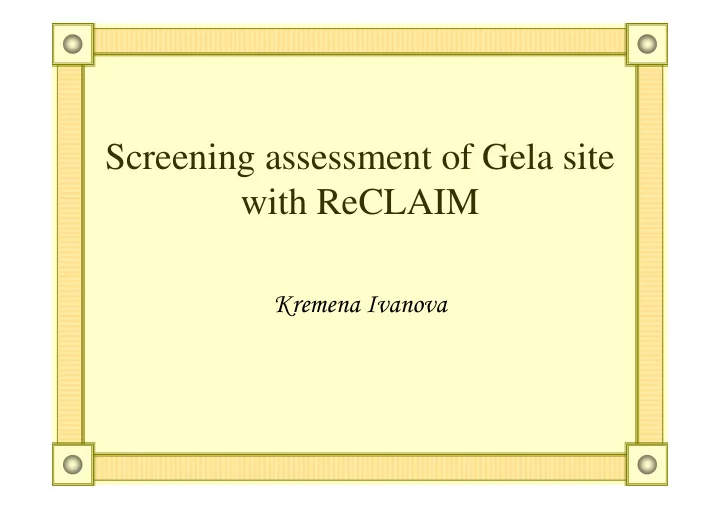

Screening assessment of Gela site with ReCLAIM Kremena Ivanova
1. Identify the problem (1) Phosphogypsum disposal site (Gela) Site consists of one large phosphogypsum stack approximately 1-2 km from the sea and the radium activity concentration is about 500 Bq/kg.
1. Site investigation and characterization (1) Historical data: • Between 1967 and 1981, phosphogypsum residues were directly discharged into the sea • Between 1981 and 1992, residues were cumulated in the landfill • In 2002 an external wall, made with bentonite cement was constructed; this wall penetrates 3 m into the slab of underground clay. Measurements of ratio 234U:238U in downstream can indicate if the retaining wall is functioning as required. • Future plans for the site include decommissioning of the phosphoric acid plant.
1. Site investigation and characterization (2) Information about industral process: 400 10 3 t a t a -1 -1 (1) phosphorite consumption: 350 – 350 – 400 10 (2) type of process: mainly Prayon – mainly Prayon – wet et process process 100 10 3 t a- t a- 1 (3) production of phosphoric acid: 60 - 100 10 60 - 300 10 3 t a t a -1 -1 (4) production of slurry: 300 10 (5) the concentration of phosphogypsum in the slurry was 10 – 20 %; (6) until 2000 there was no regulatory requirements applicable to this site from a radiological point of view;
1. Site investigation and characterization (3) A retaining wall surrounds the stack to restrict the flow of leachate is 60 cm thick, 3,550 m long, at a distance of about 5 m from the heap of residues Leachate extracted from these wells is pumped back to the top of the stack. A drainage trench between the wall and the heap was construted, with a series of wells to collect rainfall percolate. The whole trench was lined with waterproof materials.
1. Site investigation and characterization (4) Landfill, composed of 4 basins (one is empty), is about 55 ha wide; the mean height of phosphogypsum residues is 14.5 m.
1. Site investigation and characterization (5) The groundwater flow is towards the sea. Groundwater completely depends on rainfalls, which is very rare but intense; for long periods in a year piezometers and wells, outside the N-NW side of the stack are dry .
Measured concentrations of radionuclides in phosphogypsum and phosphorites. Nuclide Concentration in Concentration in phosphogypsum phosphorites [Bq.kg -1 ] [Bq.kg -1] 226 Ra 418±27 1249 214 Pb 313±15 1261 214 Bi 272±12 1170 212 Pb 19±1 40 212 Bi 19±2 41 234m Pa 25±4 1415 235 U 65
2. Screening criteria Screening criteria will depend on a number of factors.: • Government policy, • The location and major features of the site, • The anticipated future use of the site and surrounding areas, • The objective(s) of the screening assessment ect. 0.3 mSv/a 0.3 mSv/a or 1 mSv/a 1 mSv/a or ? mSv/a ? mSv/a Screening assessment is very conservative assessment
3. ReCLAIM (1) ReCLAIM ('Re Review of Contaminant Levels for the Assessment calculation of de minimis Inventory Model') has been developed by Nexia Solutions Ltd for the Nuclear Decommissioning Authority (NDA) . ReCLAIM is available to be used in assessing doses to site operators and future exposed groups related to the risks from radioactive contamination in soil and water, and calculating soil and water screening levels for radioactive contamination on nuclear licensed sites. ReCLAIM v3.0 was developed in Microsoft Excel 2002 under Windows XP SP1 32 bit.
3. ReCLAIM (2)
3. ReCLAIM (3) ReCLAIM v3.0 works the following three modes of operation: • Default Models. - contains two default exposure scenario models. The first, default model 1, is based on Oatway and Mobbs (2003) and the second, default model 2, is based on the RCLEA methodology (DEFRA, 2007) • User-defined Parameter. – This mode of operation takes the calculations a step forward towards a more site specific assessment, by allowing changes to default parameter • User-defined Scenario. – This mode allows the user to perform an entirely bespoke or site specific contaminated land assessment by enabling them to define and parameterise their own exposure pathway calculations for their desired scenario.
4. Screening assessment with ReCLAIM
4. Screening assessment with RESRAD 6.5 With exposure of 222 Rn
5. Consideration • The results of ReCLAIM satisfy the screening criteria but the results of RESRAD 6.5 do not satisfy the screening criteria • Do more realistic assumptions and exposure scenarios - strike off some exposure pathways • Reduce screening criteria to 0.3 mSv/a
6. Assessment with ReCLAIM
7. Assessment with RESRAD 6.5
8. Consideration • More investigation and characterisation of the site • More hydrological data • Collecting of groundwater and soil sampling around the landfill • Make the detail assessment
Recommend
More recommend